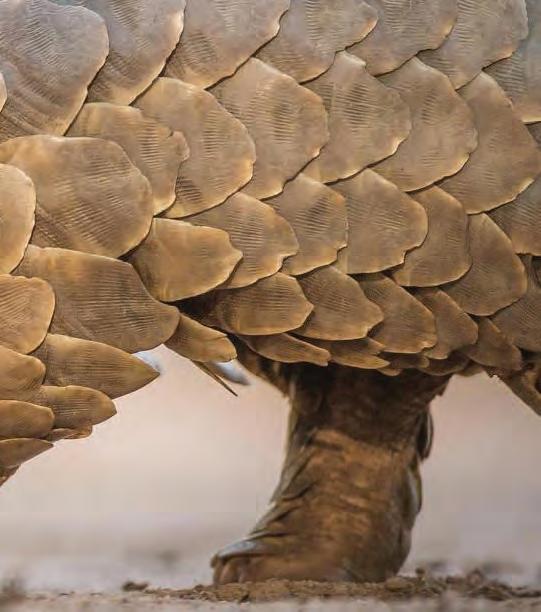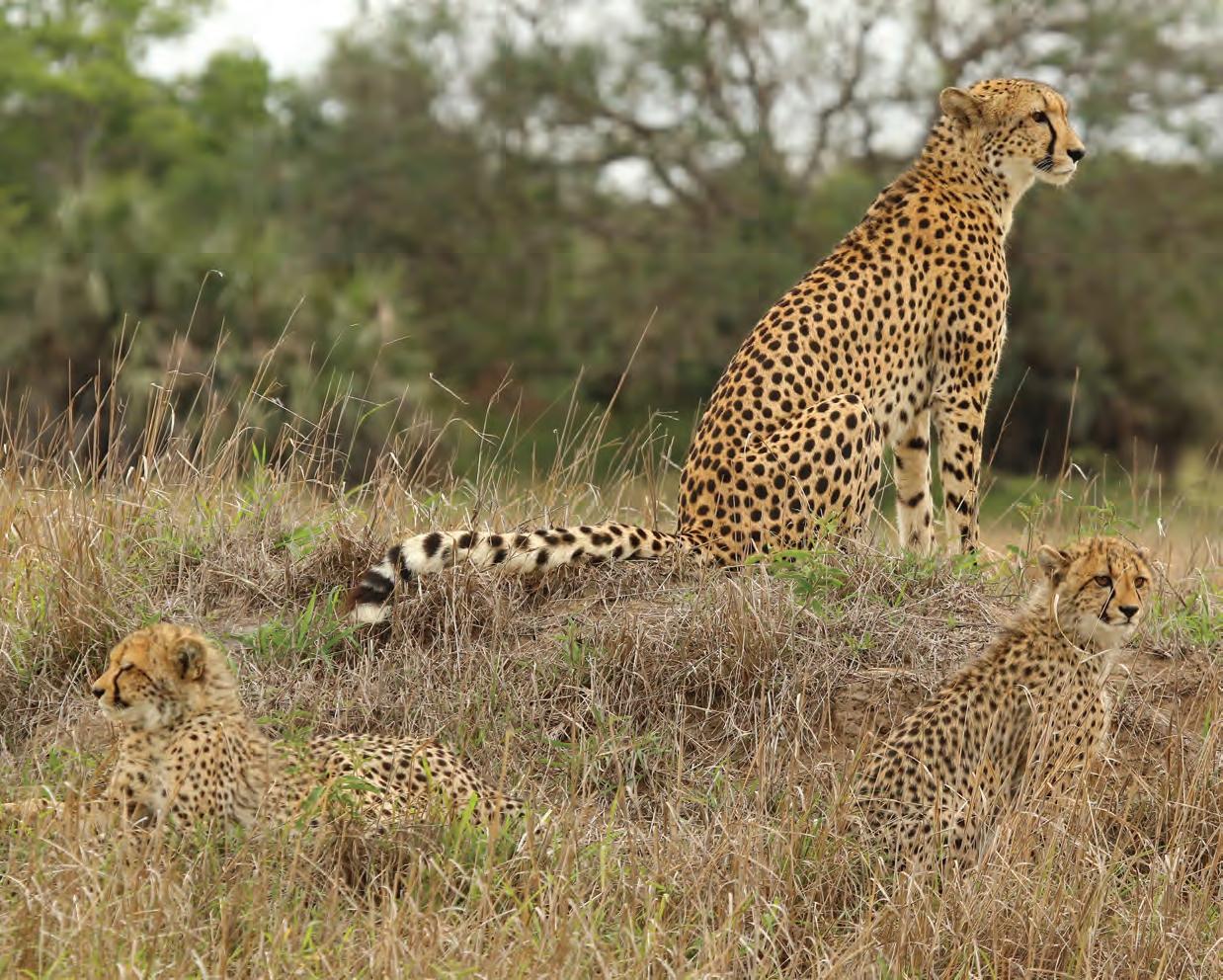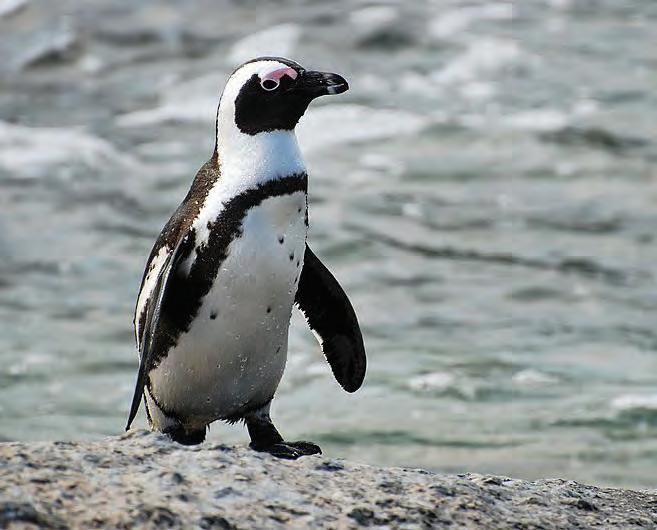
13 minute read
Species on the precipice?
CONSERVATION
As individuals, are we aware of the innumerable endangered animals
Advertisement
that now overwhelmingly teeter on the brink of extinction? A recent report from the Intergovernmental Science-Policy Platform on Biodiversity and Ecosystem Services (IPBES), says ‘nature is declining globally at rates unprecedented in human history — and the rate of species extinctions is accelerating, with grave impacts on people around the world now likely.’
Countless species are firmly entrenched on the International Union for Conservation of Nature (IUCN) Red List of Threatened Species thanks to habitat loss, human encroachment, illegal hunting, traditional medicine, and so on. Do we really want to be the final generation to witness them in the wild? “Through ‘transformative change’, nature can still be conserved, restored and used sustainably – this is also key to meeting most other global goals. By transformative change, we mean a fundamental, system-wide reorganization across technological, economic and social factors, including paradigms, goals and values.” said IPBES Chair, Sir Robert Watson. According to the report, the average abundance of native species in most major land-based habitats has fallen by at least 20%, mostly since 1900. More than 40% of amphibian species, almost 33% of reef forming corals and more than a third of all marine mammals are threatened. The picture is less clear for insect species, but available evidence supports a tentative estimate of 10% being threatened. At least 680 vertebrate species had been driven to extinction since the 16th century and more than 9% of all domesticated breeds of mammals used for food and agriculture had become extinct by 2016, with at least 1,000 more breeds still threatened. “Ecosystems, species, wild populations, local varieties and breeds of domesticated plants and animals are shrinking, deteriorating, or vanishing. The essential, interconnected web of life on Earth is getting smaller and increasingly frayed,” said Prof. Settele (IPBES Germany). “This loss is a direct result of human activity and constitutes a direct threat to human well-being in all regions of the world.” The report states that since 1970 the global human population has more than doubled (from 3.7 to 7.6 billion), rising unevenly across countries and regions; and per capita gross domestic product is four times higher – with ever-more distant consumers shifting the environmental burden of consumption and production across regions. And the average abundance of native species in most major land-based habitats has fallen by at least 20%, mostly since 1900. The numbers of invasive alien species per country have risen by about 70% since 1970, across the 21 countries with detailed records. The distributions of almost half (47%) of land-based flightless mammals, for example, and almost a quarter of threatened birds, may already have been negatively affected by climate change. Source - IPBES
In an African context much of this biodiversity loss and land degradation can be attributed to population growth - which in turn leads to habitat loss and human encroachment, which then leads to human-wildlife conflict. African cultural traditions, such as the use of bush meat and the muthi trade and a growing demand in Asia for use in traditional Chinese medicine and as a status symbol has seen a rapid increase in poaching. Those poaching for the pot have been enticed by the financial rewards of risk and have become the wildlife source for the traffickers and criminal syndicates.
POACHING:
Rhinocerous
White rhino (Ceratotherium simum) Black rhino (Diceros bicornis)
The current rhino poaching crisis is thought to have actually began in Zimbabwe, where the difficult socioeconomic and political climate facilitated rhino poaching. Once the easy pickings were taken in Zimbabwe, poaching gangs turned their attention to neighbouring South Africa, which in turn saw huge increases in poaching. Around 2013, the South African crisis spread to other countries in Africa. First Kenya was hit hard: its worst year for poaching was in 2013 when 59 animals were killed (more than 5% of the national population). In 2015, both Zimbabwe and Namibia suffered losses: Namibia lost 80 rhinos to poaching, up from 25 in 2014 and just two in 2012, while in Zimbabwe at least 50 rhinos were poached in 2015, more than double the previous year. For Africa as a whole, the total number of rhinos poached during 2015 was the highest it had been in two decades.

important for rhinos to thrive in the future. While anti-poaching measures are still a high priority, it’s important that we don’t forget the other tools in the box: biological management, community engagement, capacity building, national and international coordination, and putting in place the long-term sustainable financing needed for important rhino conservation programmes. While it is encouraging to see South Africa’s poaching numbers fall, the rhino populations are at tipping point. We cannot afford to lose any more rhinos: we must do everything possible to protect remaining populations to help their numbers increase.
It is extremely encouraging that more people were arrested and prosecuted than previous years; stopping corruption and speeding up prosecution processes continues to be critically important if we are to truly tackle this horrific illegal trade.
In a single decade between 1979 and 1989, half of all Africa’s elephants were lost to the ivory trade, according to pan African census conducted by STE’s Iain Douglas-Hamilton. Amid public outrage over the crisis, in 1989 Kenya burned her stockpile of ivory in protest at the trade and the world’s international wildlife trade body CITES banned all international trade in elephant tusks. For the next decade the trade lay dormant and African elephant populations began to recover. By 2007 it was estimated to be between 470,000 and 690,000. But a new crisis was brewing, fuelled by demand for ivory particularly in China where a demographic and economic boom had taken place. The forests of Central Africa were the first to be hit by the new wave of killing that resulted from this new demand. Between 2002 and 2011 it is estimated that the world’s forest elephant population was reduced by 62%. As Central Africa’s elephant numbers plummeted the poaching pressure began to move to the savannahs of East Africa. In 2009 Save the Elephants recorded a spike in poaching rates and their research estimates that the number of elephants killed for their ivory between 2010 and 2012 was 100,000. The demand for ivory in the far East is the primary driver of the killing. In the four years up to 2014 the wholesale price of raw ivory in China tripled, reaching a per kilo dollar price of 2,100. Botswana is presently home to roughly one third of Africa’s largest elephant species and is a popular destination for tourists seeking the scenery of the ancient Kalahari Desert and the huge concentrations of wildlife in Chobe National Park. Botswana has faced severe poaching problems and within the last several years has made significant investments in the protection of its wildlife including wildlife relocation to safer internal areas; wildlife monitoring through governmental and non-governmental organizations, including Elephants Without Borders; and support from its tourism industry. In early September of 2018 the carcasses of 87 elephants were discovered within Botswana’s interior, dating back over a period of only several weeks, and were found with their tusks removed. Compared to recent years, having so many elephants illegally killed for ivory in a several week period is unprecedented. Historically poaching has been extremely limited and antipoaching efforts have been focused on the vulnerable borders, not the interior of the country. Elephant poaching statistics in South Africa from 1980-2020 reveal that the majority of poaching incidents since 2014 have occurred in Kruger National Park where 22 elephants were killed during 2015 - the previous year had only two illegal killings. This had followed a roughly 14-year period of no recorded elephant poaching within the park (2000-2013). There was an increase again in 2016 with 46 elephants poached. Throughout 2017 there were 67 poached in KNP and one illegally killed elsewhere in the country. The year of 2018 saw a slight increase with 71 elephants illegally killed in KNP and one elsewhere in the country, demonstrating for a fourth year in a row the intentional targeting by organized criminal syndicates of elephants in eastern South Africa bordering Mozambique. Kruger National Park and Marakele National Park were both victims of elephant poaching in 2019, with the country losing a total of at least 31 elephants that year. South Africa reported only 16 incidents of elephant poaching in 2020 and attributed a portion of this decline to the COVID-19 pandemic that impacted many countries in 2020. According to the Department of Environment, Forests and Fisheries, all elephant poaching incidents reported in the country happened in Kruger National Park.
Source - SaveTheElephants.org
Pangolin (Pholidota)

Pangolins, which have existed for about 84-million years, are now under threat of extinction. There are four species of Pangolins in Africa: Temminck’s ground pangolin, giant ground pangolin, blackbellied pangolin, and the white-bellied pangolin. Of the four species, the Temminck’s ground pangolin is the most widespread and second-largest of the four species, occurring from northern South Africa through most of East Africa and into southern Sudan and southern Chad. The giant ground pangolin is the largest and rarest of the African pangolin species, is nocturnal and inhabits forests and forest-savanna in Central and West Africa, marginally entering East Africa as well. The black-bellied pangolin has large scales which are often a rich ochre colour with dark borders - the skin is black, contrasting with the ochre scales and resulting in this species arguably being the most beautiful pangolin species, and the white-bellied pangolin, a small, arboreal species which is fairly widespread and is also the species most frequently encountered, nevertheless they are by no means common. As a defence mechanism pangolins curl up into an impenetrable ball, which works really well against predators, but unfortunately makes them really easy for poachers to pick up. This has resulted in them being the most-trafficked non-human mammal on the planet. “If something isn’t done within the very small window we have right now, I think all species are going to be faced with a certain level of extinction,” said Ray Jansen, the founder and chairperson of the African Pangolin Working Group. Although large predators, starvation, fires and possibly disease pose a threat to wild pangolins, most threats facing pangolins today are of a human origin – poaching for the domestic and international trade. Pangolins are poached, mostly for their scales, which is used in several traditional Chinese medicines. Pangolin meat, too, is regarded as a delicacy in China and Vietnam.

Domestic trade probably poses the largest threat to African pangolins at present, although the illegal international trade is rapidly emerging as a major threat. All four African pangolin species are widely used in Traditional African Medicines, known locally as Muthi. Some cultures believe that pangolins are the greatest gift that can be bestowed on a person of authority and in the past many pangolins were presented to tribal chiefs and minsters as a sign of respect. This tradition is still practiced in some parts of Africa. There are also a number of traditional beliefs regarding pangolins. Some cultures believe that seeing a pangolin during the day indicates that a drought is imminent, and the only way to ward off the drought is to sacrifice the pangolin next to a river. Other cultures use pangolin fat to ward off evil spirits while still others believe that carrying a pangolin scale or a vial of pangolin blood will protect you from danger. Some cultures use pangolin scales as part of their traditional dress. In Central and West Africa pangolins are predominantly used as a source of food. Many villagers in these areas view pangolins as just another variety of protein or bushmeat, and they are hunted as such. Some cultures hold pangolin meat in high esteem and serve pangolin meat to dignitaries or on special occasions. After being captured and killed, the pangolins are roasted over a fire or boiled to remove the scales, which are discarded, and the meat preserved. Until recently the international trade has focused predominantly on the Asian pangolin species. The recent precipitous decline in these populations and the challenges facing law enforcement in Africa, in combination with increased trade agreements between Africa and Asia, has resulted in the African pangolin species being increasingly targeted to supply the insatiable Asian demand.
Most of these animals and derivatives are destined for China and Vietnam, although significant seizures have also been made in various European countries. China and Vietnam are believed to be the main enduser countries with the European countries mainly acting as conduits, although some of the pangolins imported into Europe as bushmeat are destined for expatriate communities living in these countries. The illegal international trade is likely to become the most significant threat to African pangolin species in the near future. Pangolins have become a highly prized commodity, illegally trapped, killed, and trafficked by organized crime networks between countries and continents. According to the Wild Justice Commission, between 2016-2019, an estimated 206.4 tons of pangolin scales were confiscated from 52 seizures. With a ton of scales equating to about 1,900 pangolin killed. When you do the math, the 206 tons equate to almost 400,000 poached animals! The Wildlife Justice Commission believes this is only a fraction of the total being trafficked, as it is likely that a significant proportion of smuggling passes undetected.
HABITAT LOSS:
Cheetah (Acinonyx jubatus)

Cheetah once occurred in large and connected populations that stretched all the way from South Africa up to Egypt and westwards to Senegal. Today, these populations have become severely fragmented into 29 subpopulations, with only one population estimated to number more than 1000 individuals. This is in large part due to the rapid growth of the human population – in Africa, this population has increased from approximately 100 million people in 1850 to 1.2 billion today and will continue to grow over the coming years, while during the same period, the resident range of the Cheetah decreased by 89%. Continued substantial growth of the human population will mean further habitat loss for Cheetah, further fragmentation of existing habitat, further loss of prey, more retaliatory killings due to livestock predation and more illegal trade in Cheetah as they are sought for the exotic pet trade by the ever-expanding elite in the developing world, as well as for their skins. This outlook may seem depressing, but all hope is not lost. Since 1965, conservation efforts in South Africa have resulted in the reintroduction of wild Cheetah, through the Cheetah Metapopulation Project, into 53 smaller, fenced reserves across the country. Despite major economic development and human population growth in South Africa, South Africa’s wild Cheetah population has increased from approximately 400 individuals in 1965 to over 1200 today. South Africa is the only country, worldwide, that has seen considerable growth in Cheetah numbers.
Source - Endangered Wildlife Trust
African Penguin

(Spheniscus demersus)
African penguin populations, which breed in Namibia and South Africa, have declined by 95 percent since preindustrial times. The rise in commercial fisheries have forced penguins to feed on less nutritious prey and often have to swim miles farther to find food – in addition to this, climate change and ocean warming are making the penguins’ prey even more scarce. Living along the major global oil transport route, results in them often getting caught up in oil spills. In addition to degradation of their marine habitat, penguins’ face habitat loss of their preferred nesting sites ‘Before the advent of artificially produced fertiliser, guano was considered a top-quality fertiliser rich in nitrogen, phosphorous and potassium. Guano (an Inca word for a mix of eggshell, feathers, decayed corpses, and bird excrement) was scraped from the penguin breeding islands. Penguins used to build their nests by burrowing into the thick layers of guano. This “forced removal” from well protected, temperature-controlled burrows to open surface nests, exposed the African Penguin to the harsh African heat and occasional flooding the “open-plan” living arrangement turned their eggs and chicks into an easy meal for predators like gulls & skuas.’
Source - Dyer Isalnd Conservation Trust
But it’s not all doom and gloom. Through the efforts of NGO’s, various conservation bodies, law enforcement as well as committed stakeholders in the tourism/ conservation industry, there have been inroads made into what on the surface looks a depressing and dismal situation.










